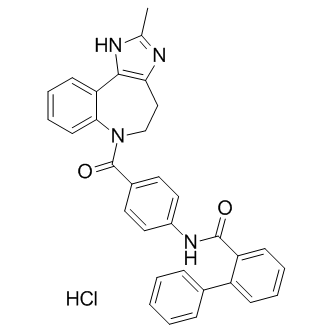
Conivaptan hydrochloride
CAS No. 168626-94-6
Conivaptan hydrochloride( YM-087 )
Catalog No. M12574 CAS No. 168626-94-6
Conivaptan (YM-087)?is a potent, selective nonpeptide vasopressin V1A and V2 receptor antagonist with Ki of 0.48 nM and 3.04 nM respectively.
Purity : >98% (HPLC)
 COA
COA
 Datasheet
Datasheet
 HNMR
HNMR
 HPLC
HPLC
 MSDS
MSDS
 Handing Instructions
Handing Instructions
| Size | Price / USD | Stock | Quantity |
| 5MG | 33 | Get Quote |


|
| 10MG | 53 | Get Quote |


|
| 25MG | 119 | Get Quote |


|
| 50MG | 214 | Get Quote |


|
| 100MG | 357 | Get Quote |


|
| 200MG | 537 | Get Quote |


|
| 500MG | Get Quote | Get Quote |


|
| 1G | Get Quote | Get Quote |


|
Biological Information
-
Product NameConivaptan hydrochloride
-
NoteResearch use only, not for human use.
-
Brief DescriptionConivaptan (YM-087)?is a potent, selective nonpeptide vasopressin V1A and V2 receptor antagonist with Ki of 0.48 nM and 3.04 nM respectively.
-
DescriptionConivaptan (YM-087)?is a potent, selective nonpeptide vasopressin V1A and V2 receptor antagonist with Ki of 0.48 nM and 3.04 nM respectively; less potent for OT receptors and no effect on V1B receptor; blocks AVP-induced cAMP production of cultured renal epithelium cells concentration dependently and has no agonistic activities.Other Indication Approved(In Vivo):Conivaptan (0.03, 0.1 and 0.3 mg/kg, i.v.) dose-dependently increases urine volume and reduces urine osmolality in both myocardial infarction and sham-operated rats. Conivaptan (0.3 mg/kg i.v.) significantly reduces right ventricular systolic pressure, left ventricular end-diastolic pressure, lung/body weight and right atrial pressure in myocardial infarction rats. Conivaptan (0.3 mg/kg i.v.) significantly increases dP/dt(max)/left ventricular pressure in myocardial infarction rats. Conivaptan produces an acute increase in urine volume (UV), a reduction in osmolality (UOsm) and, at the end of the investigation, cirrhotic rats receiving the V(1a)/V(2)-AVP receptor antagonist does not show hyponatremia or hypoosmolality. Conivaptan also normalizes U(Na)V without affecting creatinine clearance and arterial pressure. Conivaptan (0.01 to 0.1 mg/kg, i.v.) exerts a dose-dependent diuretic effect in dogs without an increase in the urinary excretion of electrolytes, inhibits the pressor effect of exogenous vasopressin in a dose-dependent manner (0.003 to 0.1 mg/kg i.v.) and, at the highest dose (0.1 mg/kg i.v.), almost completely blocks vasoconstriction caused by exogenous vasopressin. Conivaptan (0.1 mg/kg, i.v.) improves cardiac function, as evidenced by significant increases in left ventricular dP/dtmax, cardiac output and stroke volume, and reduces preload and afterload, as evidenced by significant decreases in left ventricular end-diastolic pressure and total peripheral vascular resistance in dogs with congestive heart failure.
-
In Vitro——
-
In VivoConivaptan (0.03, 0.1 and 0.3 mg/kg, i.v.) dose-dependently increases urine volume and reduces urine osmolality in both myocardial infarction and sham-operated rats. Conivaptan (0.3 mg/kg i.v.) significantly reduces right ventricular systolic pressure, left ventricular end-diastolic pressure, lung/body weight and right atrial pressure in myocardial infarction rats. Conivaptan (0.3 mg/kg i.v.) significantly increases dP/dt(max)/left ventricular pressure in myocardial infarction rats. Conivaptan produces an acute increase in urine volume (UV), a reduction in osmolality (UOsm) and, at the end of the investigation, cirrhotic rats receiving the V(1a)/V(2)-AVP receptor antagonist does not show hyponatremia or hypoosmolality. Conivaptan also normalizes U(Na)V without affecting creatinine clearance and arterial pressure. Conivaptan (0.01 to 0.1 mg/kg, i.v.) exerts a dose-dependent diuretic effect in dogs without an increase in the urinary excretion of electrolytes, inhibits the pressor effect of exogenous vasopressin in a dose-dependent manner (0.003 to 0.1 mg/kg i.v.) and, at the highest dose (0.1 mg/kg i.v.), almost completely blocks vasoconstriction caused by exogenous vasopressin. Conivaptan (0.1 mg/kg, i.v.) improves cardiac function, as evidenced by significant increases in left ventricular dP/dtmax, cardiac output and stroke volume, and reduces preload and afterload, as evidenced by significant decreases in left ventricular end-diastolic pressure and total peripheral vascular resistance in dogs with congestive heart failure.
-
SynonymsYM-087
-
PathwayGPCR/G Protein
-
TargetVasopressin Receptor
-
Recptorvasopressinreceptor1a|vasopressinreceptor2
-
Research AreaOther Indications
-
IndicationOther Disease
Chemical Information
-
CAS Number168626-94-6
-
Formula Weight535.0354
-
Molecular FormulaC32H27ClN4O2
-
Purity>98% (HPLC)
-
Solubility10 mM in DMSO
-
SMILESO=C(NC1=CC=C(C(N2CCC(NC(C)=N3)=C3C4=CC=CC=C42)=O)C=C1)C5=CC=CC=C5C6=CC=CC=C6.[H]Cl
-
Chemical Name[1,1'-Biphenyl]-2-carboxamide, N-[4-[(4,5-dihydro-2-methylimidazo[4,5-d][1]benzazepin-6(1H)-yl)carbonyl]phenyl]-, hydrochloride (1:1)
Shipping & Storage Information
-
Storage(-20℃)
-
ShippingWith Ice Pack
-
Stability≥ 2 years
Reference
1. Tahara A, et al. J Pharmacol Exp Ther. 1997 Jul;282(1):301-8.
2. Tahara A, et al. Cardiovasc Res. 1998 Apr;38(1):198-205.
3. Nakayama S, et al. Neurocrit Care. 2016 Apr;24(2):273-82.
molnova catalog



related products
-
RG7713
RG7713 (RO5028442, RG-7713) is a potent, highly selective, brain-penetrant vasopressin 1a (hV1a receptor) antagonist with Ki of 1 nM.
-
Conivaptan hydrochlo...
Conivaptan (YM-087)?is a potent, selective nonpeptide vasopressin V1A and V2 receptor antagonist with Ki of 0.48 nM and 3.04 nM respectively.
-
OPC-51803
OPC-51803 is an orally available nonapeptidylpressor (AVP) V(2) receptor selective agonist for the treatment of urinary incontinence and nocturia.



 Cart
Cart
 sales@molnova.com
sales@molnova.com


